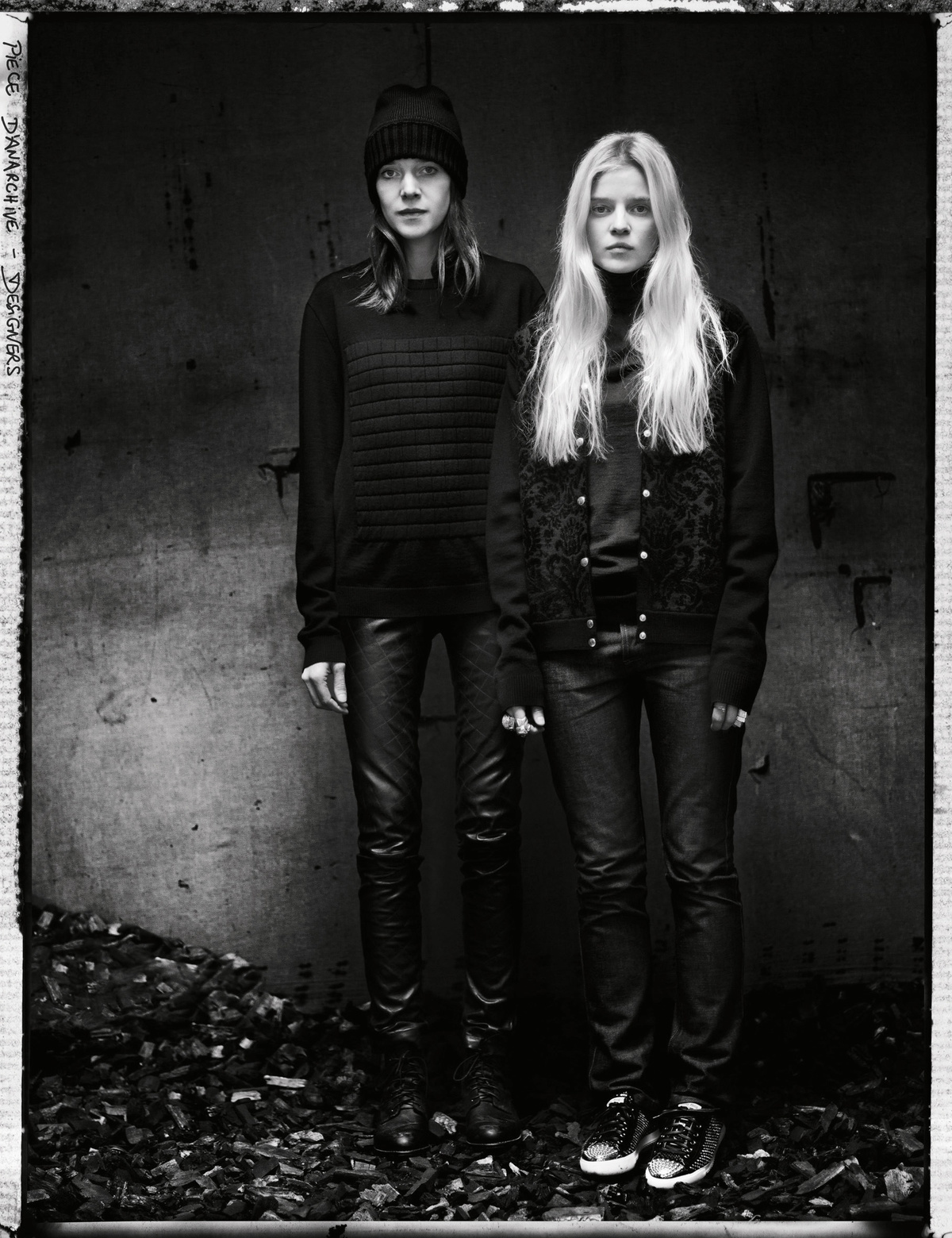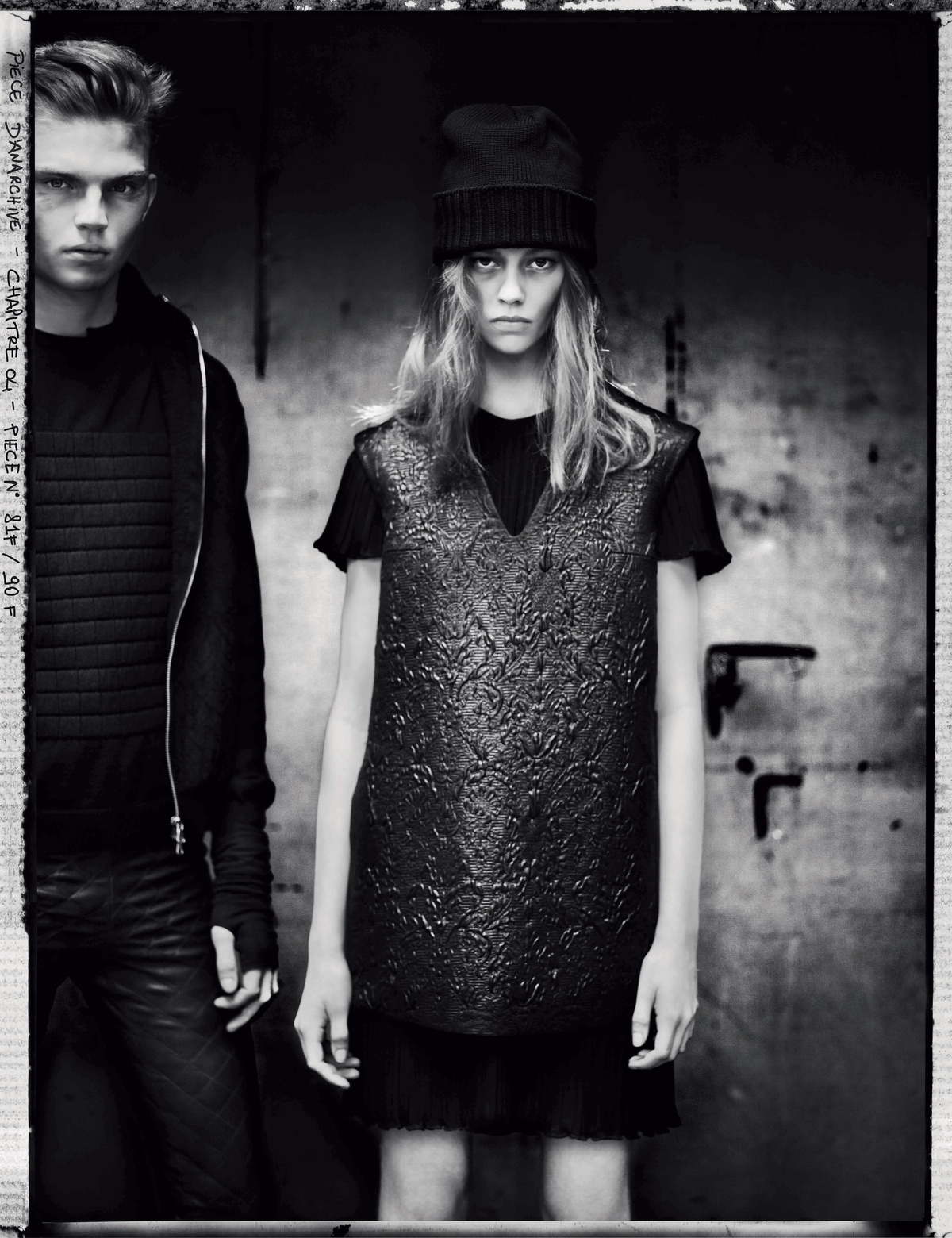Paolo Roversi’s lens has framed the most beautiful faces in the kindest light, from the nude Natalia Vodianova portrait – the one everybody has a postcard of – to Kate Moss laughing shyly behind her hand, and Guinevere, lovely Guinevere. So what did the legendary photographer, whose career has spanned three decades, see in two unknown French sisters and their small label? Titled Piece d’Anarchive, a hybrid term mixing anarchy and archive, the label was founded by sisters Déborah and Priscilla Royer, with their friend Virginie Muys. Their first collection, for spring/summer 12, established knitwear roots with numbered pieces concerned with craft and masculine, modern tailoring. The girls charmed one of the last standing French knit factories into producing their designs, with some items carrying four different stitches fusing delicate materials like guipure lace and cloqué cloth. Anarchy was never so detailed. Their charm preceded them upon meeting Paolo in Paris, 2011, where the sisters shared their sketches and a collaboration of mighty proportions began. Paolo has been working with the girls ever since, photographing Arizona Muse in brooding black and white for spring/summer 13 and Ondria Hardin looking hard for autumn/winter 13.

What happened in your first meeting?
Deborah: We were shaking a bit before Paolo came in. He didn’t talk a lot, he listened, trying to catch the vibes. He asked a lot of questions about the name of the brand…
Paolo: Yes, I was seduced by the name. It’s very close to my spirit. The first impression is very important and I had a good feeling about Priscilla and Deborah immediately. All the rest is just details, important of course, but what was strong for me was to meet these two girls and to feel very good waves coming from them to me.
What did you recognise in each other?
Deborah: Passion and a genuine, honest approach to work.
Paolo: What I recognised was a desire to do something new. I have been in fashion for many years, I am an old photographer and I’ve met a lot of designers and worked with a lot of different brands, but to meet Deborah and Priscilla was very refreshing for me, like a new dream.
What surprised you about Paolo?
Deborah: He loves vodka, and charades. He’s very good at charades!
I think anarchy doesn’t need so many words. It’s just a spirit. It’s a position you take in society that is against. – Paolo Roversi
What is your definition of anarchy?
Deborah: Through our work, anarchy means stand up for what we believe in. It also relates to the possibility of mixing different universes and blurring the codes of opposite worlds.
Paolo: That’s a great definition, but too many words for me! I think anarchy doesn’t need so many words. It’s just a spirit. It’s a position you take in society that is against.
Is fashion political? Is every outfit a statement, is every picture a statement?
Paolo: Oui, every picture is a document, is a testimony of a mood, of a moment, of a time and of course politics too because it’s always linked with society. But on the other hand, it’s not about politics. It’s about dreams, beauty, seduction, desire, and crossing another world. Politics don’t come inside my studio, they stay out of the door.
Deborah: Every outfit is a statement, if not a political one, at least a statement of who you are, what you believe in and what you want to share with the world.
How do you feel about fast fashion and fast images in the digital age?
Paolo: I am very old fashioned, I am not very excited by the internet, by instagram, by Youtube, all these things. For me photography is not just an image floating on a screen, it’s something different. I like pictures in books, in papers, in the world, even in your wallet, but not on the iPhone, I’m not excited by the electronic image.
Deborah: I think it makes me more sad than excited, because it all becomes more and more… faire-savoir rather than savoir-faire.
Paolo: Wow, faire-savoir rather than savoir-faire! Yes, now everybody feels they are a creator. Everybody’s a photographer, everybody’s a filmmaker, and it’s not like that, it is a profession, a savoir-faire and not faire-savoir… Sorry I had to! I love that, I adopt immediately.
Why is archiving still important in the digital age?
Paolo: David Bailey did an interview recently, and the interviewer asked him what he would advise young photographers, and he said: to take care of their copyright. The archive is very important because it’s our work, our treasure, so once again, the photograph is not just an image arriving everywhere, and the copyright is very important to protect the image. In my archive I have the first pictures I did when I was eighteen years old, and they are labelled, number one, number two, number three.
Deborah: It’s super difficult to preserve your archive, but for the times when you feel lost, you need to go back to your roots.
Paolo: Oui, this is a very famous Chinese proverb, when you don’t know where to go, look where you’re coming from.
Deborah: You could be a buddha!

Would you say you have an artistic temperament?
Deborah: I wouldn’t say I have an artistic temperament…
Paolo: But you have a temperament! Voila!
Deborah: [laughs]. I don’t consider myself an artist because our approach to fashion is very pragmatic and concrete, even if we have to keep dreaming to make it happen. I think Paolo is the only artist here.
Paolo: No, it’s not true. I think you can do commercial work with a very artistic spirit, and you can do art with a very commercial spirit. A good temperament, an anarchic temperament is already a big part of being an artist, because what is art? It’s about taking risks and going where you have never been before.
Do you need to be in the mood to create?
Paolo: Of course, you need to be in a certain state of mind, to have a certain desire and excitement. You cannot push buttons, now I create, now I stop for lunch, now I create again, it doesn’t work like that.
Deborah and Priscilla, where did you grow up?
Priscilla: In the countryside, in the middle of the fields in the North East of France.
Paolo: That’s why they are so free maybe.
What did you fight about when you were little?
Deborah: We grew up in a conservative environment. Our mum made us dress the same way because it was more convenient, but it was frustrating for us. She [Priscilla] always wanted to wear princess dresses, but they weren’t so suitable for the country!
Paolo: Ahh, that’s where the anarchy came from! And you never fought about boys?
Priscilla: No, and the boys would lose anyway.
Paolo, what attracts you to a person professionally?
Paolo: I look in your eyes, I want to know your life, I want to know everything. I love people, so I want to have an exchange, for me to take a picture of someone is an exchange. To take a picture is also to give a picture. I’m always curious about people, because through others I learn more about life. You have nurtured many amazing models from the beginning of their careers.
Do you feel an instinct to protect?
Paolo: No, I don’t think they need me to be protected, I think they are very strong and powerful girls. I think it’s not protection what I give to them, it’s really a collaboration, and this I hope will last for the rest of our lives.
Credits
Text Sarah Raphael
Photography Paolo Roversi
Styling Sheila Single
Hair Franco Gobbi at Artlist
Make-up Marie Duhart at l’Atelier 68
Models Ondria Hardin at Premier, Timothy Kelleher at D1.
All clothing Piece d’Anarchive
